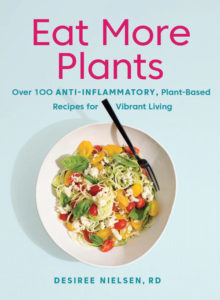The foods we eat create a cellular connection that can either cause or fight chronic inflammation in our bodies. This connection is what first interested Desiree Nielsen, author of cookbook Eat More Plants (Penguin, 2019), in becoming a registered dietitian more than a decade ago.

Foods known to have anti-inflammatory properties include raw nuts, green leafy vegetables, avocados, apples and olive oil. In contrast, refined carbohydrates—think white breads and pastas—as well as processed meats and sugary drinks can increase inflammation.
Short-term, or acute, inflammation can be a good thing: It’s what allows our bodies to heal after an infection or injury. But as Nielsen explains, when left unchecked, chronic, long-term inflammation can manifest in a host of physical conditions, including arthritis, diabetes, cancer, heart disease, digestive disorders, and even anxiety or depression.
The main goals of an anti-inflammatory diet, Nielsen says, include keeping blood sugar stable by avoiding hyper processed foods; increasing quality fats—like avocado oil and extra-virgin olive oil—while reducing saturated fats; and prioritizing gut health by choosing plant-based foods that promote a healthy, beneficial mix of gut bacteria. “Many plants have naturally occurring chemicals that are directly anti-inflammatory,” Nielsen says.
With an abundance of research documenting its anti-inflammatory effects, garlic is one of Nielsen’s go-to flavor sources. “Garlic has vital chemicals like diallyl sulfide and alliin, and these are strongly anti-inflammatory molecules,” Nielsen says. “It also contains a type of prebiotic fiber called a fructan, so it can be very beneficial for feeding the gut.”
In her recipes, Nielsen also loves to incorporate seeds, like hemp and flax, that are rich in healthy omega-3 fats, as well as raw or natural cocoa powder. “Cocoa powder has flavonoids, which are well researched for fighting inflammation,” she says. “Permission to eat chocolate? Absolutely!”
In addition to recipes like Healthy Breakfast Cupcakes and Lentil and Walnut Tacos, Eat More Plants includes a 21-day meal plan to help with the transition to a plant-based menu.
Nielsen says the effort is worth it. “In my [dietitian] practice, I get to see people transform their lives through their diet every day,” she says. “When they add these incredibly nutrient-dense, anti-inflammatory plant foods into their routines, it not only has a massive impact on their health, but they also feel more energized.”
To Fight Inflammation, Eat More of These:
- Apples
- Avocados
- Beans and lentils
- Beets
- Berries
- Broccoli
- Garlic
- Greens
- Mushrooms
- Nuts and seeds
- Sweet potatoes
- Tomatoes

